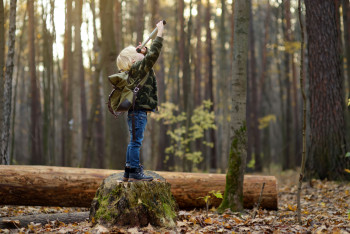As safe as necessary: A new approach to play
Posted on January 31, 2024 by the Canadian Paediatric Society | Permalink
Topic(s): Mental health, Paediatric practice, Position statements / practice points, Safety and injury prevention
Safety measures that aim to protect children can become harmful when they are too restrictive, says Dr. Émilie Beaulieu, paediatrician in Quebec City and lead author of a new position statement on the importance of risky play.
“Children should be kept as safe as necessary during play, not as safe as possible,” she said.
“Risky play might involve some minor scratches and bruises, but that is not something we should be worried about. Keeping our children active and mentally healthy is also a very important aspect to consider.”
Dr. Beaulieu said children need free play, especially outdoors, for healthy development and to maintain their physical, mental, and social well-being. While adults may worry about the inherent risks associated with free play—such as falling off a play structure—Dr. Beaulieu said the benefits far outnumber the drawbacks.
“We know that risky play is very helpful for physical health: Kids are more active and improve their motor skills, for example. It is also beneficial for mental health, including better self-esteem and better friendships and interactions with their peers.”
Also, it’s important to recognize that a risk is not the same as a hazard, said Dr. Beaulieu.
Risky play encourages a child to recognize and evaluate the challenge and decide how to approach it based on their preferences and self-perceived skill. For example, “How high can I go on this climbing structure?” A hazard is a different story: It has potential for injury beyond a child’s capacity to recognize or manage the danger. For example, an improperly anchored slide could topple under a child’s weight.
“The idea of risky play may seem new and surprising, but there’s a lot of literature on it,” said Dr. Beaulieu. “It is already accepted in many countries, especially Nordic countries like Finland. Children in those countries are not getting more severe injuries. It’s just a different way of thinking about play.”
In part, this new approach was prompted by the implications of increasingly restrictive safety measures in Canadian child care settings, schools, and playgrounds in recent years.
Those restrictions may have prevented bumps and bruises but also inhibited children’s ability to explore, be imaginative, and build their confidence and skills.
“Free play is crucial in building the foundation for a child’s health and development. Engaging in free play can impact and prevent a range of different health issues,” said Dr. Beaulieu.
“Restrictive rules about play at home, daycare or school have impacted public health. Safety is important, but there needs to be a more balanced approach when it comes to precaution.”
Dr. Beaulieu hopes that the position statement will encourage paediatricians to speak with families about the benefits of outdoor risky play, stating that it may be an especially helpful strategy in managing issues related to mental health, behavioural challenges, or active living.
“As paediatricians, we discuss sleep and eating habits with families all the time. Discussing risky play is just another aspect of their lives that we should address and ask questions about,” she said.
To read the position statement, visit https://cps.ca/en/documents
Copyright
The Canadian Paediatric Society holds copyright on all information we publish on this blog. For complete details, read our Copyright Policy.
Disclaimer
The information on this blog should not be used as a substitute for medical care and advice. The views of blog writers do not necessarily represent the views of the Canadian Paediatric Society.
Last updated: Sep 16, 2025

